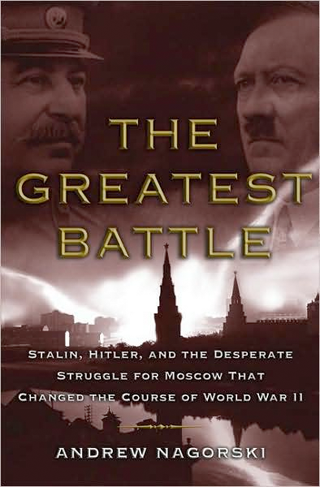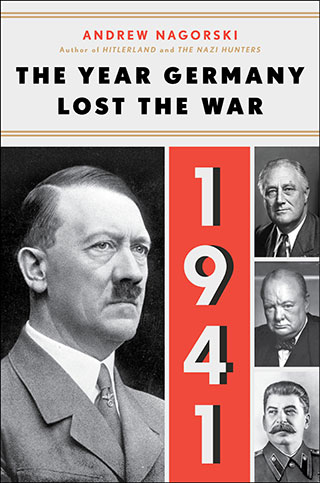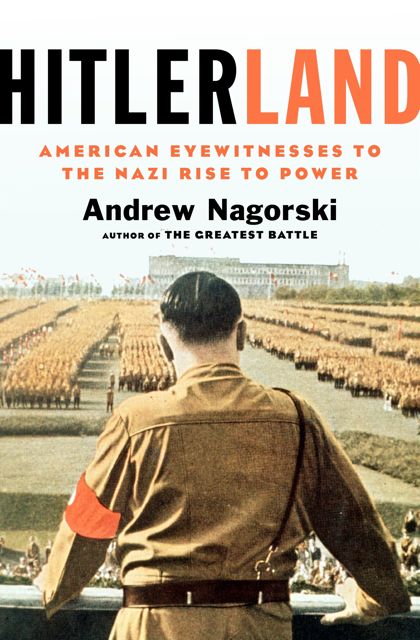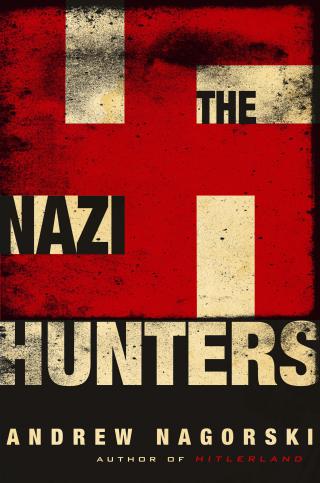Unlike most books about Americans abroad, Andrew Nagorski’s Hitlerland is less interested in the Americans themselves than in what they saw or didn’t see while they were away from home. Once the Nazis come onstage, everyone else tends to become a minor player, and Nagorski’s Americans are no exception.Hitlerland, therefore, is about perceptions of Nazism’s origins and evolution from 1922, when the first American official interviewed an obscure agitator named Adolf Hitler, until December 1941, when every American national was expelled from the Reich.
Prominent among those who failed to see the impending catastrophe was Charles Lindbergh, the heroic emblem of aviation’s glamorous present and brilliant future. Lindbergh, who had moved his family to Europe following the kidnapping and murder of his eldest child, visited Germany five times between 1936 and 1939. Officially lionized, taken on tours of airfields and factories, lavishly entertained by Air Marshal Hermann Göring, and awarded one of the country’s highest civilian honors, Lindbergh made no effort to distance himself from Nazism. Hitler, he wrote to the banker Harry Davison, “is undoubtedly a great man, and I believe he has done much for the German people.” Nagorski is perhaps a bit too kind to Lindbergh: he overstates the value of the information Lindbergh provided American intelligence about German airpower and underestimates the toxicity of the Lone Eagle’s anti-Semitism. Lindbergh was not a Nazi, but he was much more than an unwilling dupe of the regime.
A few of Nagorski’s eyewitnesses merit a page or two simply because of their later prominence. Twenty-year-old John F. Kennedy, for example, spent no more than a week in Germany, during the summer of 1937. The few diary entries that provide a documentary record of this sojourn are mercifully brief: we do not learn more about the female “bundle of fun” who accompanied the future president on his travels, and we can only guess why a nightclub in Munich was “a bit different.” Kennedy’s political insights are not memorable. He believed that Hitler, like Mussolini, was popular largely because of his skills as a propagandist; as for the Germans themselves, he thought they “are really too good—it makes people gang against them for protection.”
Among the scores of American observers who appear in Hitlerland, no one loved Germany more than the novelist Thomas Wolfe. Drawn by a powerful sense of historical connection, Wolfe visited Germany six times between 1926 and 1936. During the two months he spent there in 1935, Wolfe, lulled by his love for German culture (and elated by Germans’ positive response to his novels), overlooked what had changed since Hitler took power two years earlier. But when he returned the following summer, he could no longer turn away from the brutal face of the new Reich. In a novella entitled I Have a Thing to Tell You, published in TheNew Republic in 1937, he described a train journey from Berlin to the Belgian frontier, where one of the passengers, apparently a Jew, is arrested for trying to smuggle money out of the country. The narrator (as always, the author’s alter ego, thinly disguised) responds with a mixture of pity and fear, impotence and outrage; one of his fellow passengers, an attractive young German woman, coolly blames the victim. “Those Jews!” she complains. “These things would never happen if it were not for them!” Wolfe died a year later; by then, the German government had banned his books and his German friends were, as he had feared, as “remote from me as dreams, imprisoned there as in another world.”
Nagorski’s story is largely set in Berlin, where the embassy provided the social and political center of American life. In 1930, the United States acquired the Blücher Palace, an elegant townhouse on Pariser Platz just opposite the Brandenburg Gate (and the site of the fortified monstrosity that now houses the American embassy). But before the palace could be fully renovated it was severely damaged by fire, which meant that between 1931 and 1939, the ambassador and his staff worked out of temporary quarters near the Tiergarten. By today’s standards, the embassy was small, underfunded, and poorly equipped. Nevertheless, throughout the 1920s and 1930s the United States was represented by a number of impressive men, among them Truman Smith, a decorated infantry officer who, as a junior military attaché in 1922, was the first American official to meet Hitler and later posted urgent warnings about the rapid pace of German rearmament, and George S. Messersmith, consul general in 1933–1934, whose reports vividly described to his often skeptical superiors the violence and aggression inherent in Nazism.
Following Franklin Roosevelt’s election in 1932, Frederic Sackett, the former Republican senator from Kentucky who had been Herbert Hoover’s ambassador to Germany, was replaced by William E. Dodd, a professor of history at the University of Chicago. Dodd was not the president’s first (or second or third) choice, but he seemed well qualified for the job.
A respected scholar who had published a formidable body of work on American history, Dodd knew Germany from his years as a graduate student in Leipzig at the turn of the century. With his firm progressive convictions and modest demeanor, the new ambassador embodied the best of American values. Dodd turned out to be dutiful, well intentioned, and perceptive, but he was not a successful diplomat. Hitler regarded “good old Dodd” with contempt, refused to believe that he could speak German, and saw him as infrequently as possible.
Dodd himself grew to despise the Nazi regime. “My task here is to work for peace and better relations,” he wrote in 1934. “I do not see how anything can be done so long as Hitler, Goering and Goebbels are the directing heads of the country.” Increasingly impatient with his superiors in the State Department and the Foreign Service professionals in the embassy, worn out by his efforts to live on his relatively modest salary, and frustrated by his failure to make progress on his multivolume history of the old South, Dodd became increasingly irritable and physically unwell before being forced to resign in 1937.
Like Erik Larson’s recent book about the Dodds, In the Garden of Beasts: Love, Terror, and an American Family in Hitler’s Berlin,1 Hitlerland pays close attention to the adventures of Martha Dodd, the ambassador’s twenty-four-year-old daughter. Unemployed and energetic, Martha spent her ample free time pursuing a vigorous social life that revolved around love affairs with an eclectic collection of men including tourists like Thomas Wolfe, Germans like Rudolf Diels, the head of the Berlin Gestapo, and Boris Vinogradov, ostensibly a Soviet diplomat but actually a NKVD agent.
Martha arrived in Berlin without strong political views—in fact she may have shown some initial enthusiasm for the Nazis—but she was gradually drawn toward communism, in part under Vinogradov’s influence, in part through her friend Mildred Harnack an American whose German husband, Arvid, was an official in the Economics Ministry with ties to the Communist underground. After returning home with her family, Martha ended up working for Soviet intelligence. When she and her well-to-do husband, Alfred K. Stern, were indicted for espionage in 1957, they fled to Prague, where she spent the last three decades of her life. Her Berlin friends were less fortunate: Vinogradov was shot by Stalin’s secret police in 1938; the Harnacks were convicted by the Nazis of espionage; Arvid was hanged in 1942, Mildred beheaded in 1943.
When she was not busy with romantic escapades or tutorials in Marxist theory with the Harnacks, Martha Dodd spent her time among the American correspondents stationed in Berlin. During the 1930s, in what now seems like the golden age of international reporting, there were fifty American correspondents in Berlin, representing wire services and broadcasting networks as well as dozens of newspapers and magazines, many of which have long since disappeared. Not surprisingly, Nagorski, who was himself a distinguished correspondent, makes these journalists the heroes of his book. Much of Hitlerland is based on their dispatches, letters, and reminiscences.
From 1923 until he was forced to leave Germany in September 1933, the dean of the Berlin press corps was Edgar Ansel Mowrer, who wrote for The Chicago Daily News. Installed in a spacious set of offices above the fashionable Kranzler Café on Unter den Linden, he was one of the first to see the menace in Hitler’s enormous popularity. His Germany Puts the Clock Back was written in late 1932 and then rushed into print after Hitler took power in January 1933. As the title suggests, Mowrer’s book is an early version of what historians call Germany’s “special path,” which uncovers the origins of Nazism in deeply rooted national traditions of authoritarianism and militarism.
Dorothy Thompson moved to Berlin in 1925 to write for the Philadelphia Public Ledger and the New York Evening Post. Thompson was one of the most famous journalists of her day, the model for the formidable Tess Harding in George Stevens’s classic film Woman of the Year. In 1932, she published I Saw Hitler!, which was based on an interview with the Nazi leader held the year before. As was his habit, Hitler did all the talking, addressing the reporter as if she were a crowd of followers. She was not impressed by his “soft, almost feminine charm,” nor by his diatribes against the Jews (who were, he insisted, “responsible for everything”).
Like many observers before 1933, she could not imagine that an insignificant figure like this could ever take power: “Oh, Adolph! Adolph! You will be out of luck!” Thompson was banned from returning to Germany in 1934, but continued to write about the movement that she had once so seriously underestimated. Unlike Mowrer, she did not emphasize the inherently German character of Nazism, suggesting instead that it was a political plague that could erupt anywhere.
As Hitler consolidated his power at home, built up his armed forces, and began to challenge the international order, an increasing number of ambitious young journalists scrambled to get a post in Berlin where they sensed, quite correctly as it turned out, Europe’s destiny would be forged. Among them were such future luminaries as Howard K. Smith, Richard C. Hottelet, Joseph Harsch, and William Shirer. Shirer, who would become one of Edward R. Murrow’s legendary team of broadcasters at CBS, arrived in Berlin in 1934, and reported on the German occupation of Austria in 1938, the invasion of Poland in 1939, and the Wehrmacht’s stunning victories in Western Europe. His live account of the Franco-German armistice in June 1940 became one of the great moments in the history of broadcast journalism.
In 1941, after leaving Germany one step ahead of the Gestapo, Shirer published Berlin Diary: The Journal of a Foreign Correspondent, 1934–1941, the best American eyewitness account of these years and one of the few still worth reading. Two decades later, the extraordinary and unanticipated success of his Rise and Fall of the Third Reich was the first indication of the popular fascination with Nazism that continues to inspire an apparently endless series of films, television programs, novels, and history books.
For many Americans in Berlin the most important connection to the regime was the oleaginous Ernst Hanfstaengl, known to all by his childhood nickname “Putzi.” Son of a prosperous German art dealer, his mother the member of a prominent German-American family (both of her grandfathers were Civil War generals), Hanfstaengl was, as he informed everyone who crossed his path, a graduate of Harvard College (Class of 1909), where he first showed his talent for making himself agreeable to important people. In Munich during the early 1920s, Hanfstaengl and his American wife were among Hitler’s earliest supporters. After 1933, he hovered on the fringes of the Nazi elite, always ready to sooth the Führer’s nerves by playing the piano and, rather less successfully, to offer advice on foreign relations, especially on how to deal with the United States.
Six feet four, with thick black hair and a booming voice, Hanfstaengl was a conspicuous presence on Berlin’s social scene, sometimes appearing in a brown uniform of his own design that was, as he assured his listeners, made from the finest British cloth. Many Americans were initially attracted by Hanfstaengl’s congeniality and apparent candor, traits not widely shared among leading Nazis. “I regret to say that on first acquaintance he struck me as a likeable fellow,” one reporter recalled. “You had to know Putzi to really dislike him.”
In 1937, after he fell afoul of one of the court intrigues that constantly divided Hitler’s inner circle, Hanfstaengl left Germany, eventually ending up in Washington where he used his Harvard connections to promote himself as an expert on the Nazi movement. His monumentally mendacious memoirs, written after the war, were shaped by an unresolved struggle between their author’s self-importance, which impelled him to exaggerate his influence (he claimed, among other things, that he had created the Nazis’ “Sieg Heil” salute on the model of a Harvard football cheer), and his desire to distance himself from the regime’s criminal behavior.
Americans in Hitler’s Berlin were a privileged group, well paid, comfortably housed, and usually (if not always) protected from the intimidation and violence with which the regime confronted its critics. They inhabited a small, somewhat isolated world, populated by people who saw each other regularly at receptions and press conferences, and then repaired to the Hotel Adlon for martinis followed by late-night dinners at Die Taverne, a popular Italian restaurant.
When the European war began in September 1939, life in Berlin became more difficult even for these privileged Americans. Food and fuel were hard to get, blackouts made travel awkward, while air raid warnings and, after September 1940, RAF bombing raids interfered with normal social life. As Washington’s support for Britain became more apparent following Hitler’s swift victories in 1940, tensions between the American journalists and their German hosts steadily increased. After Hottelet was arrested in March 1940 and imprisoned on espionage charges for four months, reporters could no longer assume that the regime’s displeasure would bring them nothing worse than expulsion. By late 1941, only fifteen American correspondents remained in Berlin.
For officials at the American embassy, finally installed in its splendid new quarters on Pariser Platz, the years from 1939 to 1941 were frustrating and exhausting. There was no resident ambassador. Hugh Wilson, the career diplomat who had replaced William Dodd, spent only a few months in Berlin before being recalled in November 1938 as a protest against the anti-Semitic violence on Kristallnacht. Since Wilson did not return to his post, the embassy was directed by the chargé d’affairs with the help of George F. Kennan, then a promising young foreign service officer who was transferred from the Prague embassy to Berlin in September 1939.
Between 1939 and the declaration of war in December 1941, diplomatic relations between Germany and the United States were stagnant. With military victory apparently in sight, Hitler had little incentive to negotiate with Washington, while isolationist opinion in the United States seriously restricted Roosevelt’s ability to put credible pressure on Berlin. Instead of diplomacy, the embassy staff was absorbed by the often heartbreaking task of dealing with growing crowds of desperate people, most of them Jews, trying to escape the tightening noose of Nazi persecution.
Amid the larger tragedy engulfing Europe, the last act of American life in Hitlerland was a blend of melodrama and farce. When Germany declared war on the United States four days after the Japanese attack on Pearl Harbor, American diplomats and journalists were rounded up and eventually interned in a rundown resort hotel in Bad Nauheim, a few miles from Frankfurt. Here Kennan found himself in charge of 132 bored, anxious, and perpetually hungry Americans, who complained constantly about their accommodations, bickered among themselves, and found innumerable ways to make his life miserable. In May 1942 they were finally exchanged for their German counterparts, who had spent a rather more comfortable internment at the Greenbriar in West Virginia.
The eyewitnesses who fill the pages of Nagorski’s book were an impressively prolific group. Before 1939, they produced hundreds of official reports, newspaper columns, magazine articles, and books. Very little of it provides deeply original, enduring analyses of Nazism’s origins and evolution. No eyewitness to the events of 1933 left an account comparable to John Reed’s vivid description of the Bolsheviks’ seizure of power inTen Days That Shook the World. There is no memoir of ordinary life in Nazi Germany with the depth and immediacy of John Scott’s Behind the Urals, which recounts the author’s experiences as a worker in the new industrial city of Magnitogorsk during the 1930s. No outsider and certainly no American came close to capturing the nuances and contradictions of Nazi society with the insight and precision we find in the magnificent diaries of Victor Klemperer, a Jew who was able to remain in Dresden throughout the war because he was married to an “Aryan” and finally escaped deportation after the city was heavily bombed in February 1945.2
The best thing that can be said about the American residents of Hitlerland is that most of them very quickly recognized the vicious character of Nazism. In contrast to Americans in the Soviet Union or Fascist Italy, it is hard to find eyewitnesses in Nazi Germany who were sympathetic to the regime. Even visitors like Lindbergh who expressed some admiration for Nazism’s achievements were more restrained than Lincoln Steffens, who, after a brief stay in the Soviet Union, famously declared, “I have seen the future, and it works.” And while prominent Americans like William Randolph Hearst and Henry Luce were willing to forgive Hitler a great deal because of his hostility to communism, most Americans who saw the regime firsthand were not. The Nazis’ blatant brutality, unapologetic persecution of the Jews, and increasingly aggressive foreign policy were too close to the surface of everyday life to be ignored or explained away.
While these Americans had few illusions about Nazism, many of them, especially those who had spent time in Germany before 1914, initially could not understand how such a law-abiding, orderly, cultivated nation could fall into the hands of demagogues and thugs. Memories of this other Germany encouraged some observers to underestimate Hitler’s potential before 1933 and others to overestimate the ability of so-called “moderates” to influence the new regime once it was in power. These illusions evaporated as soon as Hitler, through a deft combination of false promises and real violence, consolidated his control over the country. After 1934, more and more Americans began to identify Nazism with Germany. William Shirer, for example, insisted that Nazism was not the work of an alien minority: “For the last three or four years the Nazi regime has expressed something very deep in the German nature and in that respect has been representative of the people it rules.”
Nagorski describes but hardly criticizes the crude psychology of many of the writers he deals with. Instead, he celebrates how they helped people at home to understand the nature of Nazism. This, he concludes, “gradually eroded isolationist sentiments and prepared their countrymen psychologically for the years of bloodshed and struggle ahead.” True enough. But it is worth remembering that in 1941 most Americans were still quite prepared to live with Hitler’s foreign aggression and racial violence. It was not the insights and eloquence of these eyewitnesses but rather Hitler’s own decision to declare war on the United States that finally shattered the isolationist illusion and opened the way for Hitlerland’s ultimate destruction.








